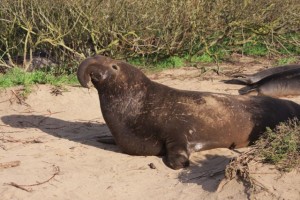
A small beach on the western side of Stanford’s Hopkins Marine Station is now ground zero for an interesting, if antagonistic, interaction between two seal species. Until recently, West Beach was a protected cove on the western edge of Stanford’s privately owned land (no public access), serving as a quiet reprieve for Harbor Seals, which recolonized the beach in the late 1990s. But that peace was recently disturbed by the appearance of a large male Elephant Seal. Male Elephant Seals are much larger and more aggressive than the diminutive and docile Harbor Seals. Elephant Seal males at this time of year are aggressively defending territories near Ano Nuevo to the north in preparation for the mating season. The first Elephant Seal appeared on the beach in 2004.
“In February 2010, [an Elephant Seal] that might have been 5 years old cleared the beach one day by biting a Harbor Seal lying beside him, sending it bleeding into the ocean,” said Thom Akeman, a volunteer docent at the Monterey Bay National Marine Sanctuary who has been observing the seals.
Elephant seals, whose numbers on the beach rarely rise above 10, generally haul out higher than harbor seals, said John Pearse, professor emeritus of biology at UC Santa Cruz, who has counted Harbor Seals on West Beach since 2003.
The number of Elephant Seals on Hopkins beaches peaks during spring molting season and in the fall. The fall seals are mostly young males that are probably avoiding mature males at the larger breeding rookeries, Pearse said. Last year, Pearse counted up to 13 elephant seals on West Beach at one time. A similarly high number was recorded in 2008, but in general, the counts range between three to six seals.
“Of course, we all wonder whether we have an elephant seal rookery in our future at [West Beach],” said Pearse, but added the outcome is unlikely because the beach is so small.
Elephant Seals have been visiting the beach at Hopkins Marine Station in P.G. A few facts:
· Diet includes octopuses, skates, small sharks and ratfish
· Males can weigh up to 4,500 pounds and females up to 1,500 pounds
· Regularly dive to depths of about 1,700 feet to catch food and avoid predatory white sharks
· In the 1800s, were hunted to near extinction for their blubber, used to make lamp oil
· Come ashore to breed, with large rookeries on the beaches of the Santa Barbara Islands, Año Nuevo and Piedras Blancas
· Gets its name from the male’s large proboscis, said to resemble an elephant’s trunk
Source: Monterey Bay Aquarium
To see the original article, go to the Monterey Herald or use this: http://www.montereyherald.com/news/ci_17145907?nclick_check=1